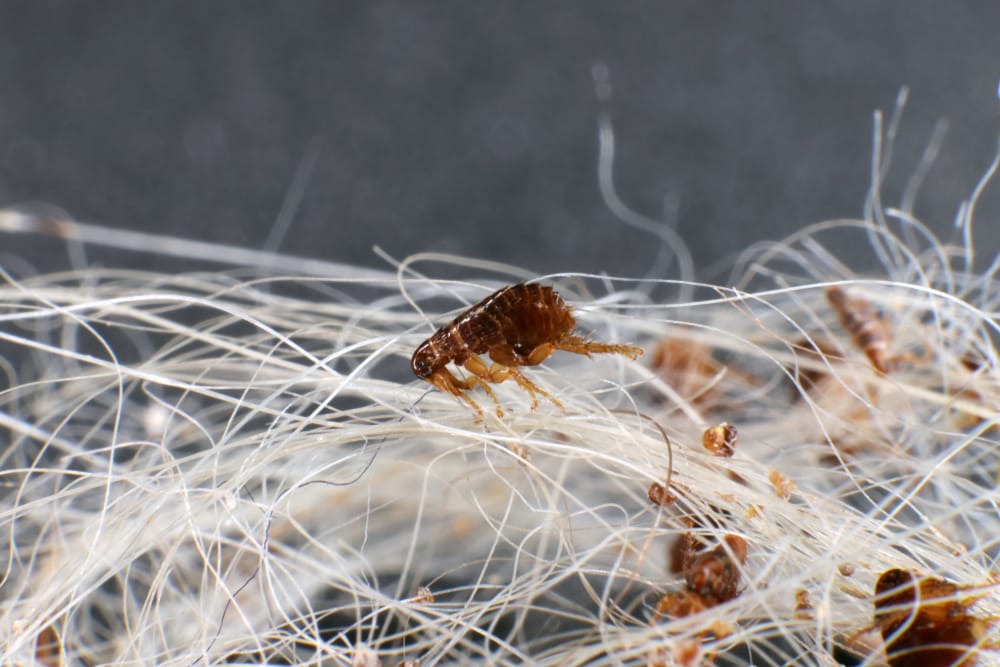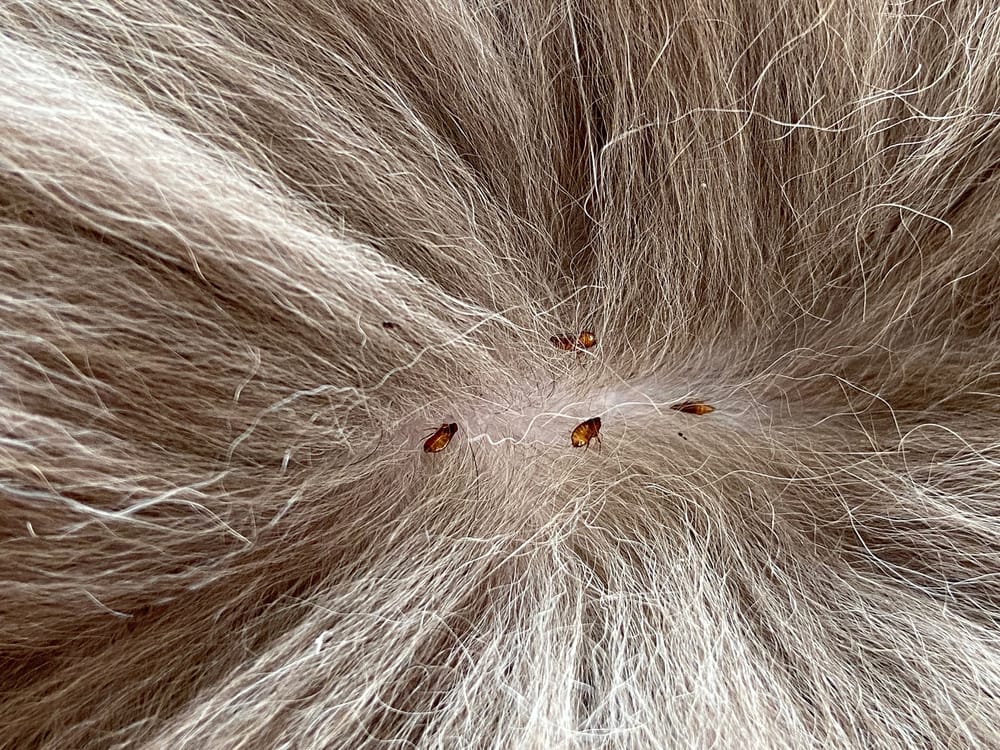It is important to have a good understanding of the life cycle of these parasites, to know their characteristics and their habits. In this way, you will be able to better predict their consequences for your pet’s health. Also know that there are effective ways to prevent future infections. This complete file will provide you with essential information that will guarantee your dog a healthy and comfortable life, while protecting your loved ones at the same time.
What is a dog flea?
Dog fleas, or Ctenocephalides canis, are tiny parasitic insects about 1 to 3 millimeters long. Just like its cousin, the cat flea, this insect is hematophagous, meaning it feeds on blood to survive. In the domestic environment, the preferred hosts are dogs and cats, but fleas can feed on human blood. Reddish-brown in color, they are wingless, but have strong legs, which enable them to jump from one host to another.
These parasites feed by piercing the skin of their host, an adult flea can bite a dog several hundred times a day. Their saliva contains substances that prevent blood clotting, which makes it easier to eat. Fleas live on their host for a relatively long time. Once established, they remain on the animal for nearly their entire lives, feeding on approximately one blood meal per day. Sometimes dogs get rid of them by biting or licking them.
Their complex life cycle includes four stages: egg, larva, nymph and adult. Understanding this cycle is key to effectively combating these parasites. Adults they lay up to 50 eggs a day directly on the dog, before those eggs fall to the ground and thus pollute the environment. When these eggs hatch 5 to 10 days after being laid, they hatch into larvae. They prefer dark and dusty areas, such as the underside of carpets or the space between floorboards.
After a period of 7 to 18 days, the larva metamorphoses into a pupa. This transformation takes place within the cocoon, a structure made of material from the salivary glands. When conditions are favorable, nymphs emerge from their cocoons after a hibernation phase that can last several months. Often the heat and vibrations, when the host passes by, awaken the cocoons. Thus, a dog that has never been in contact with fleas can catch them during its stay in a country house with parquet floors.
Fleas are seasonal parasites, they mainly develop during hot periods, spring and summer. However, things are different inside the house. Indeed, even in winter heating can have an effect comparable to summer heat and enable the awakening of dormant cocoons.

Dogs can get fleas in different ways. Parasites are often present in the environment, especially in areas frequented by other infected animals (baskets, sleeping areas, etc.). When your pet is in these places, it can easily become infected.
Another way to get fleas is through direct contact with other infected animals. If your dog plays with other dogs or cats that carry fleas, he can become a potential host.
Fleas can also be brought into the home through their hosts, cats or dogs. Once inside, fleas reproduce quickly, so infestations can occur within weeks.
What are the symptoms associated with the presence of fleas in dogs?
It is essential to know how to recognize the signs of fleas in your dog. Here are some common symptoms associated with a flea infestation:
- Excessive scratching : Flea bites cause severe itching, stimulating dog scratching often.
- Hair loss : Dogs infected with fleas may lose hair, especially at the base of the tail or on the belly.
- Small black dots : Flea excrement may be visible on the dog’s skin or hair. If you get them wet, they can take on a reddish hue because they are mostly made up of digested blood.
- Skin damage : Flea bite allergy can cause skin reactions, such as irritation, redness and rash.
- Anxious behavior : Infected dogs may become agitated, anxious or even depressed due to the discomfort caused by the bites.

What are the risks of flea infestation?
Flea infestation in dogs is not just itching and irritated skin. It also carries other risks for your pet’s health:
- Flea bite allergy : some hypersensitive animals can develop an allergy to the proteins present in flea saliva. This causes serious allergic reactions, such as intense itching, pimples or even scabs.
- Disease transmission : fleas transmit certain pathogens, especially the bacteria that cause them cat scratch disease (Bartonella henselae). They also carry tapeworm (Dipylidium caninum), an intestinal worm that parasitizes dogs.
- Anemia : In rare cases, a heavy infestation of fleas feeding on an animal can lead to anemia. Blood loss is manifested by pallor of the mucous membrane, significant fatigue and muscle weakness.
- Stress : Constant itching and discomfort caused by fleas affects your dog’s behavior, appetite or quality of life.
- Weight loss : Dogs infected with fleas may lose weight due to discomfort and decreased appetite.
- Secondary infections : Skin lesions caused by flea bites can become infected with bacteria or fungi, requiring antibiotic treatment. These secondary infections cause additional itching.
Therefore, it is crucial to take the presence of fleas on your dog seriously and act quickly to remove them.
When it comes to the treatment of fleas in dogs, it is essential to take a comprehensive approach to the elimination of these parasites and prevent their return. Here’s how to effectively treat fleas on your dog:
- Identify the infestation : The first step is to confirm the presence of fleas on your dog. You can do this by examining his skin and coat for fleas, flea droppings and signs of skin irritation. If in doubt, consult your veterinarian.
- Treating your dog : several options are possible among treatments antiparasitic for dogs (shampoos, pipettes, flea tablets or collars). Consult your veterinarian to determine the most appropriate treatment for your dog based on its age, size and health.
- Treat the environment : Fleas hide in carpets, rugs, pet beds and other parts of the house. It is necessary to treat your dog’s environment with special flea products. Wash your pet’s bedding regularly at a high temperature (at least 60°C) to remove fleas and their eggs. It is recommended to use a household insecticide in the form of a spray or an automatic sprayer.
- Maintain regular hygiene : THE regular brushing of your dog can help quickly detect the presence of fleas and remove eggs and droppings. Take care to keep your dog’s environment clean, vacuuming the areas where he stays often.
- Use natural products : If you prefer more natural flea control options, some essential oils are effective. Lavender, peppermint and eucalyptus are known to repel fleas. However, be sure to consult your veterinarian before using these products.
- Continuous prevention : once the infestation is under control, apply preventative treatments to prevent re-contamination of your dog. Topical antiparasitics should be administered as recommended by your veterinarian.
- Consult your veterinarian : If your dog’s symptoms persist or worsen and he shows signs of allergy, consult a specialist. Additional treatment or medical attention may be required.

